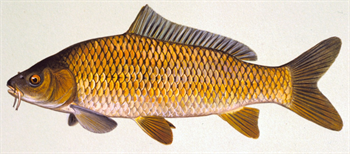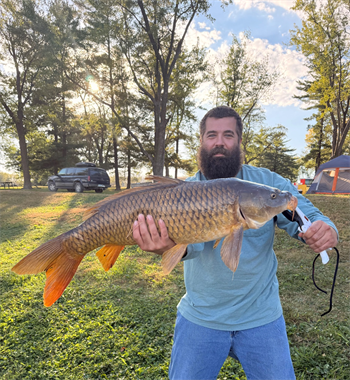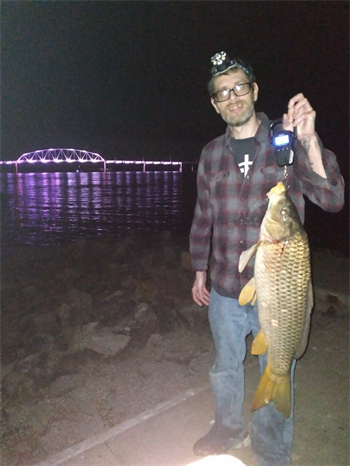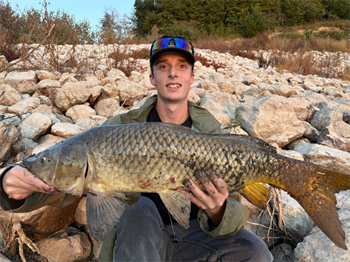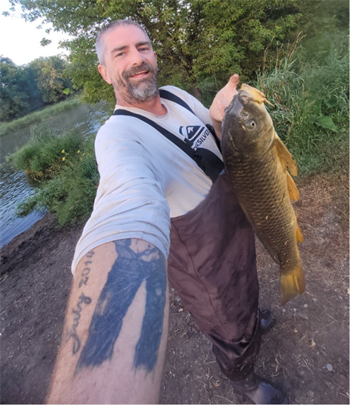Fish Iowa - Fish Species - Common Carp
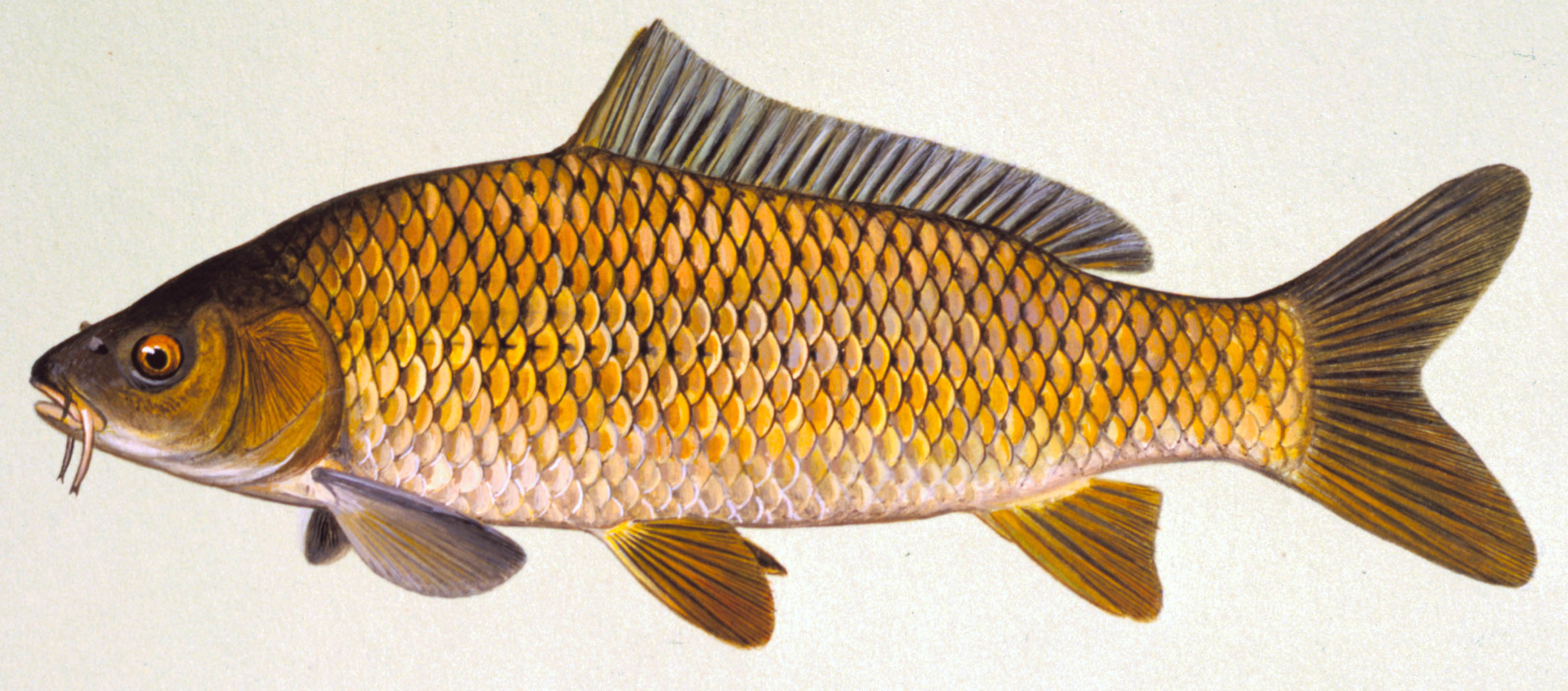
Characteristics
A large minnow, with adults weighing up to 50 pounds or more. Its robust body is compressed laterally, and a soft, fleshy mouth opens ventrally. A stout, serrated, spinous ray at the leading edge of the dorsal and anal fins is a distinctive physical characteristic. There are more than 16 soft rays in the dorsal fin (native cyprinids have less than 10) and 4 to 6 soft rays in the anal fin. Pectoral fin soft rays are 14 to 17, and pelvic fin soft rays are 8 to 9. A visible barbel extends from the posterior corner of the upper jaw and a smaller, less visible one is found along the side of the upper jaw. The lateral line is complete and may have 33 to 44 scales. Body scales are large, displaying a diamond-shaped look and have a black dot in the front of each scale. The body is gray to olive dorsally, golden-yellow to bronzy-golden laterally, and yellowish-white ventrally. Pectoral, pelvic, and caudal fins are yellow to orange-red in adults. Young fish have a dusky vertical bar on the caudal peduncle which fades with increasing age. Pharyngeal teeth are broad and form three rows in the formula 1, 1, 3-3, 1. Molar-like grinding surfaces characterize the middle rows.
Foods
Carp are omnivorous feeders, taking both vegetable and animal matter. Aquatic insects, crustaceans, and small mollusks make up the bulk of their diet. They are particularly fond of tender roots and shoots of young aquatic plants and often "root-up" large quantities of vegetation and silt in their search for food.
Expert Tip
Carp love to explore and feed in newly flooded areas; try using worms or dough balls when the river is rising.
Details
The Common Carp is extremely adaptable and can be found in many habitats; it is least successful in clear, high gradient streams. It is abundant in low gradient, warm waters of lakes, reservoirs, and soft-bottomed, weedy pools of streams. High populations can be found in lakes and reservoirs that are artificially fertilized with organic wastes or runoff from farmlands, essentially eutrophic. It is often found by piles of drift, logs or other submerged cover. It is tolerant of a wide range of turbidities, bottom types and temperatures.
Common Carp prefer warm water, either standing or with sluggish flow. They are most abundant in large rivers, man-made lakes and natural lakes where there is abundant, soft organic matter on the bottom. Carp adapt better than most fish species to pollution caused by sewage or agricultural run-off. They thrive in heavy effluent stretches and are very tolerant of turbid waters.
Carp are a nuisance in shallow, weedy habitat where their activity creates high turbidity in otherwise clear water. Carp have a limited use in nuisance aquatic vegetation control programs.
Spawning occurs from mid-April through June when the adhesive eggs are scattered in the shallow water over vegetation, debris, logs or rocks. Splashing carp, with their backs out of the water, may be seen in shallow waters during spring. Females can spawn more than 500,000 eggs over several days, leaving several thousand at each spawning site.
Three varieties of Common Carp are found in Iowa. The most abundant and widespread is the fully scaled fish. Leather carp are scaleless, and mirror carp are covered with only a few large mis-shapen scales. Both leather and mirror carp are rare, and the former variety may have been extirpated because of its very unique genetic make up.
The reputation of carp has gone through an interesting transition since its North American introduction. Originally, its purpose was to provide a fine food-fish to replace rapidly dwindling native fishes -- notably Eastern Trout. Its easy adaptation to pond culture and high-quality protein were touted as major attributes. Carp were distributed widely across the United States by the U.S. Fish Commission during the last part of the 19th century, but problems developed quickly as carp escaped from pond culture and spread into other habitat -- soon distribution and stocking stopped.
Carp can dominate other fish species. Carp, in their normal activities can change the aquatic habitat, and man has altered natural environments that favor carp.
This fish was viewed with disdain, and many projects to remove carp occurred in the early 1900`s through the 1960`s. Most projects failed to eliminate carp, and few showed improvements in native species populations. During this same time, carp became a major commercial food-fish, being taken from the Great Border Rivers and natural lakes. Care is still used to prevent stocking of carp, and it is illegal to release this species into public waters. Projects to remove carp are still carried out as a part of overall fish management efforts, especially during lake and watershed restoration projects.
Common Carp are harvested by commercial fishermen extensively from the Mississippi River. About 200,000 pounds of Common Carp valued at nearly $25,000 are annually harvested from the Mississippi River.
Recent stream sampling information is available from Iowa DNR's biological monitoring and assessment program.
Sources:
Harlan, J.R., E.B. Speaker, and J. Mayhew. 1987. Iowa fish and fishing. Iowa Conservation Commission, Des Moines, Iowa. 323pp.
Loan-Wilsey, A. K., C. L. Pierce, K. L. Kane, P. D. Brown and R. L. McNeely. 2005. The Iowa Aquatic Gap Analysis Project Final Report. Iowa Cooperative Fish and Wildlife Research Unit, Iowa State University, Ames
Illustration by Maynard Reece, from Iowa Fish and Fishing
Distribution Map

One of the most abundant and widely distributed fish in Iowa. Initially introduced into our waters from Europe more than a century ago, and since then this fish has naturalized into nearly all waters. They live in nearly every stream, river, man-made lake, and natural lake unless specific effort has been made to eliminate them. They are least common in cold water streams and farm ponds.
See our most recent distribution data for this species on the Iowa DNR's Bionet application.
State Record(s)
Master Angler Catches
Fish Surveys
Tip: Click Species Length by Site, then use the dropdown to filter by fish species of interest.Where this Fish Is Found
Ada Hayden Heritage Park Lake
Alice Wyth Lake
Arbor Lake
Atlantic Quarry Pond 1
Atlantic Quarry Pond 2
Atlantic Quarry Pond 3
Atlantic Quarry Pond 4
Avenue of the Saints Pond
Backbone Lake
Banner Lake (south)
Bartlett Lake
Bays Branch
Beeds Lake
Big Creek Lake
Big Lake (Including Gilbert's Pond)
Big Lake (Lansing)
Big Sioux River
Big Timber Complex
Big Woods Lake
Black Pit
Blue Heron Lake (Raccoon River Park)
Blue Lake
Bob White Lake
Boyer River (Dunlap to Missouri River)
Briggs Woods Lake
Burlington Street Dam
Carter Lake
Cedar Lake
Cedar Lake
Cedar River (above Nashua)
Cedar River (Cedar Rapids to Moscow)
Cedar River (La Porte City to Cedar Rapids)
Cedar River (Moscow to Columbus Junction)
Centerville Lower Reservoir
Chain-O-Lakes Area
Clear Lake
Copper Creek
Coralville Reservoir
Cox Pond
Deep Lakes
Des Moines River (Farmington to Keokuk)
Des Moines River (Ottumwa Dam to Farmington)
Des Moines River (Saylorville to Red Rock)
Des Moines River (Stratford to Saylorville Lake)
Des Moines Water Works Recharge Basins
Diamond Lake
Don Williams Lake
Dudgeon Lake
East Fork Des Moines (state line to Algona)
East Lake (Lenox)
East Nishnabotna River
East Okoboji Lake
Easter Lake
Elm Lake
English River
Five in One Dam
Folsom Lake
Fontana Mill Lake
Gateway Park North
Gilbertson Pond
Grays Lake
Independence Impoundment
Iowa River (Columbus Junction to Mississippi R)
Iowa River (Coralville Lake to River Junction)
Iowa River (Iowa Falls to Marshalltown)
Iowa River (Marshalltown to Coralville Lake)
Iowa River (River Junction to Columbus Junction)
Iowa River Landing Pond
Jacob Krumm Nature Preserve Lake (west)
Jay Carlson Pit (west)
Keg Creek Lake
Koutny Pond
Kuhn W.A. Quarry
Lake Cornelia
Lake Hendricks
Lake Icaria
Lake Macbride
Lake Manawa
Lake Meyer
Lake Oelwein
Lake of the Hills
Lidtke Impoundment
Limbeck Pond
Little Sioux River (Correctionville to Missouri R)
Little Sioux River (Linn Grove to Correctionville)
Little Sioux River (state line to Linn Grove)
Little Spirit Lake
Loch Ayr
Manhattan Robbins Lake Park
Martens Lake
McKinley Lake
Meyers Lake
Middle Raccoon River (above Redfield confluence)
Middle River
Middle Sabula Lake
Miller
Missouri River (Council Bluffs to state line)
Missouri River (Little Sioux to Council Bluffs)
Missouri River (Sioux City to Little Sioux)
Mohawk Park Lake
Morse Lake
Murphy Lake
Nishna Bend R.A. Ponds
North Raccoon River (above Auburn)
North Raccoon River (Perry to Van Meter)
North River
North Twin Lake
Norwegian Lake
Percival Lake
Petersons Pit, West
Plainfield Lake
Pleasant Creek Lake
Pool 11, Mississippi River
Pool 16, Mississippi River
Pool 17, Mississippi River
Pool 18, Mississippi River
Pool 19, Mississippi River
Prairie Lakes South
Prairie Park Fishery
Purple Martin Lakes
RAPP Park Lakes
RecPlex Pond
Red Rock Reservoir
Roberts Creek Lake
Rock Creek Lake
Sand Lake
Savery Pond
Saylorville Reservoir
Schley Park Pond
Schram Pond
Seminole Valley Park Lakes
Shell Rock River (above Greene)
Skunk River (Coppock to Mississippi River)
Skunk River (Rose Hill to Coppock)
Snyder Bend Lake
Snyder Pit
South Skunk River (Cambridge to Pella)
South Skunk River (Story City to Cambridge)
Spirit Lake
Spring Creek South
Spring Lake
Storm Lake (incl Little Storm Lake)
Swan Lake
Swan Lake
Terry Trueblood Lake
Three Mile Lake
Turkey River (above Clermont)
Turkey River (below Clermont)
Tuttle Lake
Twin Ponds
Vernon Springs Impoundment
Volga Lake
Walnut Ridge Pond
Wapsipinicon River (Oxford Junct to Mississippi R)
Wapsipinicon River (Troy Mills to Oxford Junction)
West Fork Des Moines (Emmetsburg to Humboldt)
West Nishnabotna River
West Okoboji Lake
West Swan Lake S.W.M.A.
Windmill Lake
